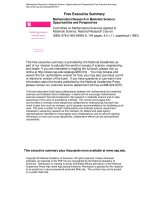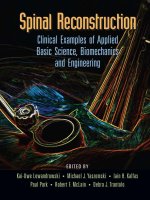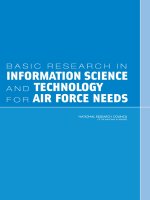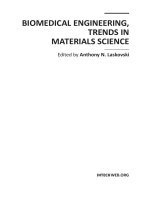Mathematical Research In Materials Science - opportunities And Perspectives pptx
Bạn đang xem bản rút gọn của tài liệu. Xem và tải ngay bản đầy đủ của tài liệu tại đây (114.32 KB, 6 trang )
Mathematical Research in Materials Science: Opportunities and Perspectives (Free Executive Summary)
/>Free Executive Summary
ISBN: 978-0-309-04930-6, 144 pages, 8.5 x 11, paperback (1993)
This executive summary plus thousands more available at www.nap.edu.
Mathematical Research in Materials Science:
Opportunities and Perspectives
Committee on Mathematical Sciences Applied to
Materials Science, National Research Council
This free executive summary is provided by the National Academies as
part of our mission to educate the world on issues of science, engineering,
and health. If you are interested in reading the full book, please visit us
online at . You may browse and
search the full, authoritative version for free; you may also purchase a print
or electronic version of the book. If you have questions or just want more
information about the books published by the National Academies Press,
please contact our customer service department toll-free at 888-624-8373.
This book describes fruitful past collaborations between the mathematical and materials
sciences and indicates future challenges. It seeks both to encourage mathematical
sciences research that will complement vital research in materials science and to raise
awareness of the value of quantitative methods. The volume encourages both
communities to increase cross-disciplinary collaborations, emphasizing that each has
much to gain from such an increase, and it presents recommendations for facilitating such
work. This book is written for both mathematical and materials science researchers
interested in advancing research at this interface; for federal and state agency
representatives interested in encouraging such collaborations; and for anyone wanting
information on how such cross-disciplinary, collaborative efforts can be accomplished
successfully.
Copyright © National Academy of Sciences. All rights reserved. Unless otherwise
indicated, all materials in this PDF file are copyrighted by the National Academy of
Sciences. Distribution or copying is strictly prohibited without permission of the National
Academies Press Permission is granted for this material
to be posted on a secure password-protected Web site. The content may not be posted
on a public Web site.
Copyright © National Academy of Sciences. All rights reserved.
This executive summary plus thousands more available at
Mathematical Research in Materials Science: Opportunities and Perspectives
/>1
SUMMARY AND OVERVIEW
Materials science is broadly concerned with the nature, properties, and use of materials. One materials
science area of great significance is solid-state physics, which focuses on the physical properties of solid
materials. It addresses such concerns as, for example, the properties that result from the distribution of electrons
in metals, semiconductors, and insulators; oscillations in crystals; energy bounds; magnetic phenomena;
dielectrics; ferromagnetics; and dislocations. Another materials science area of great importance is that of
polymers, for which an additional concern about liquid flow arises. Whatever the context, be it solid, liquid, or
some transitionary setting, materials science seeks an understanding of a material's macromolecular structure and
properties by drawing on knowledge of its atomic and molecular constituents.
Until recently, the term ''materials science'' was used primarily to denote empirical study, fundamental
research, synthesis, and production in metallurgy and ceramics. Today, the term is used in a broader context that
involves interdisciplinary interactions among scientists, engineers, mathematicians, physicists, chemists, and
biologists who are concerned with one or more of the four basic elements of modern materials science:
properties, structure and composition, synthesis and processing, and performance (National Research Council,
1989). Traditional boundaries between disciplines sometimes needlessly constrain the development of
unorthodox ideas and new theories. The National Science Foundation recognized this in establishing a number of
interdisciplinary science and technology centers, many of which include several institutions and often several
disciplines (National Science Foundation, 1993, 1992). In particular, materials science is today a vast and
growing body of knowledge that is based on the physical sciences, engineering, and mathematics but is not
obliged to conform to their limits. Interdisciplinary studies encompass all classes of materials, including
biomaterials and biomolecular materials, ceramics, composites, electronic materials, magnetic materials, metals,
optical and photonic materials, polymers, and superconducting materials (Federal Coordinating Council for
Science, Engineering and Technology, 1992). Physics, chemistry, mechanics, and other traditional disciplines are
now viewed as an arsenal of complementary scientific approaches serving the common goal of increased
knowledge about and understanding of all aspects of materials, from discovery and synthesis to products and uses.
The mathematical sciences, for comparison, originally were developed as an integral part of the physical
sciences. Often the same individuals contributed to both areas of research. With the exponential growth of all
these areas has come increased specialization such that, in particular, the mathematical sciences and materials
sciences are separate disciplines with too little contact between them.
The basic objectives of materials science are the synthesis and manufacture of new materials, the
modification of materials, and the understanding and prediction of materials properties and their evolution over
time. In each of these areas, the disciplines mentioned above play a role. The mathematical sciences, as a
common language for the quantitative description of processes and phenomena, have their own unique role.
They provide a
SUMMARY AND OVERVIEW 1
About this PDF file: This new digital representation of the original work has been recomposed from XML files created from the original paper book, not from the original typesetting files. Page breaks are true
to the original; line lengths, word breaks, heading styles, and other typesetting-specific formatting, however, cannot be retained, and some typographic errors may have been accidentally inserted. Please
use the print version of this publication as the authoritative version for attribution.
Copyright © National Academy of Sciences. All rights reserved.
This executive summary plus thousands more available at
Mathematical Research in Materials Science: Opportunities and Perspectives
/>unifying force, reveal underlying structure, offer an avenue for knowledge transfer among disciplines, and serve
as the vehicle for computational modeling of the processes and phenomena. Both the mathematical and materials
sciences have much to gain from each other. Modern mathematical methods can aid in solving significant
problems in materials science, while problems in materials science can suggest fruitful areas for mathematical
research. In the larger perspective, however (National Research Council, 1989), it is clear that the scientific
vigor, technological strength, and economic health of the nation all argue in favor of universities, government,
industry, and professional societies stimulating and facilitating new collaborations between mathematical
scientists and materials scientists.
The committee's task was to prepare a broad survey that (1) identifies and describes areas where the
mathematical sciences have significantly aided materials research, (2) identifies areas of mathematical research
in which increased progress would accelerate materials research, (3) identifies obstacles, if any, to increased
collaborative research, and (4) makes recommendations for facilitating this type of cross-disciplinary work,
including how to attract students and young researchers to this area. Chapters 2 through 8 of this report address
items (1) and (2). This chapter and Chapter 9 address item (3), and Chapter 9 addresses item (4). This report is
written for both mathematical and materials science researchers with an interest in advancing research at this
interface, for federal and state agency representatives interested in encouraging such collaborations, and for any
persons wanting information on how such cross-disciplinary, collaborative efforts can be successfully
accomplished.
Concerning obstacles, it should first be noted that despite existing impediments to interdisciplinary work in
these areas, there are nonetheless many successful interactions and collaborations between materials scientists
and mathematical scientists (some are referred to in the technical Chapters 2 through 8 that follow). However,
those impediments do need to be recognized and addressed.
One obstacle to increased collaborative research between the mathematical sciences and materials science
concerns the differences in education of researchers in the two disciplines. The education of materials scientists
exposes them to varying amounts of mathematics, but it mainly involves classical mathematics and therefore
little knowledge of modern mathematics, especially tools that might be beneficial for exploring problems in
materials science. In their education, mathematical scientists rarely take physical science courses beyond the
elementary undergraduate classical courses, and therefore they generally have little feeling for current research
areas and the applications of their expertise to materials sciences. Another impediment is a large jargon barrier
that exists between the two disciplines. Similar jargon barriers exist even among different subdisciplines of
materials science (and subdisciplines of the mathematical sciences); continual efforts are needed to eliminate
jargon as a barrier to interdisciplinary research. Some negative attitudes constitute another barrier and are
perhaps best summarized by the comments of, on the one hand, the great mathematician G. H. Hardy, who
expressed his pleasure that none of his work had practical applications and, on the other hand, the materials
scientist who cautions his students that "too much rigor leads to rigor mortis." University departmental structures
that often discourage mathematical research by materials scientists and materials-oriented research by
mathematical scientists present another obstacle, as this (and other) cross-
SUMMARY AND OVERVIEW 2
About this PDF file: This new digital representation of the original work has been recomposed from XML files created from the original paper book, not from the original typesetting files. Page breaks are true
to the original; line lengths, word breaks, heading styles, and other typesetting-specific formatting, however, cannot be retained, and some typographic errors may have been accidentally inserted. Please
use the print version of this publication as the authoritative version for attribution.
Copyright © National Academy of Sciences. All rights reserved.
This executive summary plus thousands more available at
Mathematical Research in Materials Science: Opportunities and Perspectives
/>disciplinary research is generally not rewarded in considerations of tenure, promotion, and salary. A minimal
level of cross-discipline education couples with the large jargon barrier, some negative attitudes, and a lack of
motivating rewards to inhibit cross-fertilization between the mathematical and materials sciences. Chapter 9
presents the committee's conclusions regarding the main obstacles to increased collaboration between the
materials science and mathematical sciences communities. It then addresses item (4) with the committee's
recommendations to universities, government, industry, and professional societies on how to enhance and further
increase collaborative efforts between the two communities.
In making these recommendations, the committee was aware of serious difficulties that exist to developing
cross-disciplinary work, difficulties that are not unique to materials science. Progress in cross-disciplinary
research, as well as in research within a discipline, can come either incrementally or following breakthroughs.
Breakthroughs are often the result of progress on prototype problems, examples being the Ising model of a
ferromagnet (the inspiration for the renormalization group work cited in each of Chapters 3 through 6 and 8) or
Edward Lorenz's chaos sequence (x
n+1
= ax
n
− x
n
2
) that Mitchell Feigenbaum studied for his breakthrough on
chaos (Lorenz, 1963, 1979, 1984; Feigenbaum, 1978, 1981). These prototype problems provide an excellent
vehicle for cross-disciplinary communication and by their elegance and ability to challenge can attract excellent
researchers. Areas where such breakthroughs could take place might include, for example, the long time scale
behavior of protein folding or the transitions from microscale to mesoscale and from mesoscale to macroscale.
Specific candidates for such problems probably already exist, but this committee is not aware of prototypes that
have been truly simplified to an irreducible essence.
Therefore, the committee's recommendations focus on enabling incremental advances in cross-disciplinary
research that involves mathematical sciences applied to materials science. Some of the main obstacles to cross-
disciplinary efforts, such as the reward system, have been and are being addressed in a number of other reports
(for example, Joint Policy Board for Mathematics, 1994; National Research Council, 1993, 1991c, 1990, 1989;
Boyer, 1990; Sigma Xi, 1988; and Institute for Mathematical Statistics, 1988). The committee attempted to go
beyond those general difficulties and offer specific suggestions in its recommendations.
The mathematical challenges in materials science vary with length scale, time scale, and temperature regime
(Pantelides, 1992; Baskes et al., 1992). For example, quantum mechanics is the discipline that governs processes
and phenomena at the most microscopic level where electronic effects are important. Continuum mechanics and
thermodynamics govern macroscopic deformations. Statistical mechanics is one area that connects the
microscopic with the macroscopic regime. The basic laws of these disciplines have very different mathematical
structures and pose distinct challenges. In each case, the classical mathematical areas such as geometry,
differential and integral calculus, and statistics play distinct and mutually reinforcing roles. These different ways
of viewing materials science, as well as the breadth and the scope of the modern field, can lead to different ways
of breaking up the subject into categories so as to address items (1) and (2). For example, although there are not,
say, ten "outstanding problems" in materials science for mathematical scientists, one can identify ten areas with
great promise for mathematical applications to
SUMMARY AND OVERVIEW 3
About this PDF file: This new digital representation of the original work has been recomposed from XML files created from the original paper book, not from the original typesetting files. Page breaks are true
to the original; line lengths, word breaks, heading styles, and other typesetting-specific formatting, however, cannot be retained, and some typographic errors may have been accidentally inserted. Please
use the print version of this publication as the authoritative version for attribution.
Copyright © National Academy of Sciences. All rights reserved.
This executive summary plus thousands more available at
Mathematical Research in Materials Science: Opportunities and Perspectives
/>materials science: block copolymers, dynamic fracture, effective moduli of composites, grain boundaries, grain
growth, martensite and shape-memory materials, mushy regions, processing of semiconductor chips, stokesian
dynamics for complex fluids, and superconductivity. As a basic framework for description, the committee's
choice of general categories of focus or themes became the titles of this report's Chapters 2 through 8. This
organization of subjects by themes is in contrast to the committee's phase-one survey (National Research
Council, 1991a), which was organized around various classes or applications of materials (such as ceramics,
electronic and semiconductor materials, polymers, and so on). Extensive cross-referencing has been provided
between subjects or chapters when the same or a related topic is discussed elsewhere in this report. Subjects
within chapters were chosen for illustration; the lists of subjects are not meant to be comprehensive. Further, the
descriptions of those subjects and associated mathematical research opportunities present only a part of the much
more wide-ranging totality (for example, cf. Langer, 1992; National Research Council, 1991c, 1989; Psaras and
Langford, 1987). In the same way, the references given are intended to help the reader search further into the
literature, with no attempt made to be complete. What appears in this report reflects the committee members'
expertise and knowledge, that of the cross-section of individuals (see appendix) who were kind enough to
provide information to the committee, and the project limits on time and funding.
The committee hopes that this report will help encourage research in the mathematical sciences that
complements vital research in materials science, will generally raise awareness of the value of quantitative
methods in materials science, and will spur researchers to explore the interface between the mathematical
sciences and materials science. The committee also wishes to repeat the perspective expressed in its previous
short report on the subject (National Research Council, 1991a): cross-disciplinary collaborations require long-
term commitments.
SUMMARY AND OVERVIEW 4
About this PDF file: This new digital representation of the original work has been recomposed from XML files created from the original paper book, not from the original typesetting files. Page breaks are true
to the original; line lengths, word breaks, heading styles, and other typesetting-specific formatting, however, cannot be retained, and some typographic errors may have been accidentally inserted. Please
use the print version of this publication as the authoritative version for attribution.
Copyright © National Academy of Sciences. All rights reserved.
This executive summary plus thousands more available at
Mathematical Research in Materials Science: Opportunities and Perspectives
/>








